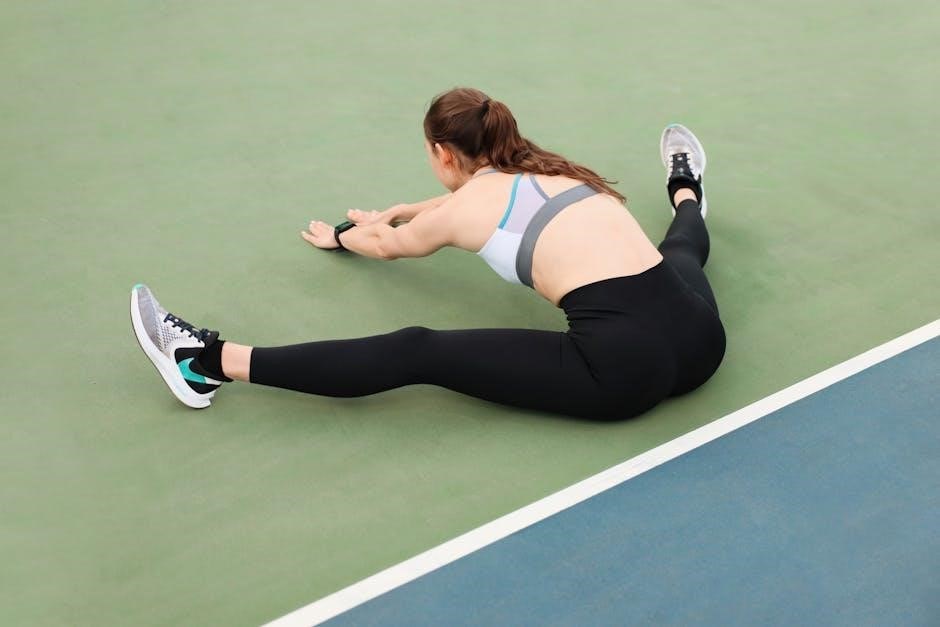Exercises for osgood schlatter disease are available online as pdf files with instructions and illustrations for stretching and strengthening muscles around the knee joint slowly․
Definition and Overview
Osgood Schlatter disease is a common condition that affects the knee joint, particularly in adolescents․ It is characterized by pain and swelling below the knee, where the patellar tendon attaches to the tibia․ The condition is often caused by overuse or repetitive strain on the knee joint, leading to inflammation and irritation of the growth plate․ A proper understanding of the condition is essential for effective management and treatment․ Online resources, including pdf files, provide a wealth of information on the definition, symptoms, and treatment options for Osgood Schlatter disease, helping individuals to better understand the condition and take steps towards recovery and prevention of further complications․ Effective management requires a comprehensive approach․
Exercises for Osgood Schlatter Disease Rehabilitation
Exercises include hamstring and calf stretches for rehabilitation slowly and gently online․
Hamstring Stretch Exercise
The hamstring stretch exercise is a common rehabilitation technique for osgood schlatter disease, which can be found in pdf files online with instructions and illustrations․ This exercise involves lying on your back and bringing your affected leg towards your chest, grabbing the back of your thigh and trying to extend your leg, holding the position for 30 to 60 seconds to feel a stretch in the back of your thigh․ The exercise should be done slowly and gently to avoid further injury, and it is recommended to repeat it several times a day to see improvement in the condition, with proper warm-up and stretching exercises․
Importance of Stretching and Strengthening Exercises
Stretching and strengthening exercises are essential for rehabilitation and preventing osgood schlatter disease slowly and effectively online always․
Prevention and Treatment
Preventing osgood schlatter disease involves proper warm-up and stretching exercises of the thigh, hamstring, and calf muscles, which may help reduce the risk of injury․ Treatment options include rest, ice, compression, and elevation, as well as physical therapy exercises to stretch and strengthen the muscles around the knee joint․ Downloading a PDF file with instructions and illustrations for various exercises can be a helpful resource for individuals looking to prevent or treat osgood schlatter disease․ By following a consistent exercise routine and taking steps to prevent injury, individuals can reduce their risk of developing osgood schlatter disease and improve their overall knee health and stability over time with proper care․

Downloading Exercise Instructions and Illustrations
Download pdf files with instructions and illustrations for osgood schlatter disease exercises online easily and quickly now available․
PDF Files and Online Resources
PDF files for osgood schlatter disease exercises are readily available online, providing easy access to instructions and illustrations for various exercises․ These resources can be downloaded and printed for convenience, allowing individuals to follow along with the exercises at their own pace․ Online resources also offer a wealth of information on the condition, including causes, symptoms, and treatment options․ Additionally, many websites provide video tutorials and demonstrations of the exercises, helping to ensure proper form and technique․ By utilizing these online resources, individuals can take an active role in managing their condition and improving their overall health and well-being, with the help of PDF files and online resources, exercises can be done effectively․

Causes and Symptoms of Osgood Schlatter Disease
Causes and symptoms include knee pain and swelling around the tibial tubercle slowly;
Understanding the Condition
To understand osgood schlatter disease, it is essential to know the causes and symptoms, which include knee pain and swelling around the tibial tubercle․ The condition affects the growth plate, leading to discomfort and limited mobility․ By recognizing the signs and symptoms, individuals can seek proper treatment and rehabilitation․ A proper diagnosis is crucial in developing an effective treatment plan, which may include exercises and physical therapy․ The goal of treatment is to alleviate pain, improve mobility, and prevent further complications․ With the right approach, individuals can manage the condition and regain normal knee function․ Osgood schlatter disease exercises can be found online as pdf files with instructions and illustrations for stretching and strengthening muscles․

Foot Strengthening Exercises for Osgood Schlatter Disease
Exercises strengthen muscles in the foot and ankle slowly and carefully every day․
Additional Rehabilitation Techniques
Additional rehabilitation techniques for osgood schlatter disease include physical therapy and orthotics to support the knee and leg․ These techniques can help alleviate pain and improve mobility․ Exercises such as heel slides and straight leg raises can be modified to accommodate individual needs․ A healthcare professional can provide guidance on proper technique and progression of exercises․ It is essential to combine these techniques with stretching and strengthening exercises to achieve optimal results․ By incorporating additional rehabilitation techniques, individuals can enhance their recovery and reduce the risk of future complications․ Proper warm-up and cool-down routines should also be included in the rehabilitation program to prevent further injury․
Exercises for Athletes with Osgood Schlatter Disease
Athletes can perform specific exercises to alleviate osgood schlatter disease symptoms slowly and carefully online․
Special Considerations for Athletes
Athletes with osgood schlatter disease require special consideration when performing exercises to alleviate symptoms․
They should focus on stretching and strengthening the muscles around the knee joint, as well as improving flexibility and endurance․
Online resources provide pdf files with instructions and illustrations for various exercises, including heel slides and quadriceps mobilization․
Proper warm-up and cool-down routines are also essential to prevent further injury․
Additionally, athletes should listen to their bodies and stop exercising if they experience any pain or discomfort․
By taking these precautions, athletes can safely and effectively manage their osgood schlatter disease symptoms and improve their overall performance․
It is essential for athletes to consult with a healthcare professional or athletic trainer to develop a personalized exercise plan․

and Recommendations
Exercises and stretching help manage symptoms and improve knee joint health slowly always online․
Final Thoughts and Advice
It is essential to follow a well-structured exercise plan to manage osgood schlatter disease symptoms and improve knee joint health․
Online resources provide valuable information and guidance on exercises and stretches to help alleviate pain and discomfort․
By incorporating these exercises into daily routine, individuals can improve their overall knee health and reduce the risk of further complications․
Consulting with a healthcare professional is crucial to determine the best course of treatment and exercise plan․
With proper care and management, individuals can effectively manage their symptoms and improve their quality of life․
Exercises and stretches can be found online as pdf files with instructions and illustrations for easy reference and implementation․




